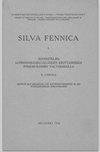Changing climatic drivers of European spruce bark beetle outbreaks: a comparison of locations around the Northern Baltic Sea
IF 1.8
3区 农林科学
Q2 FORESTRY
引用次数: 0
Abstract
European spruce bark beetle (Ips typographus [L.]; SBB) damage has reached extreme and unprecedented levels in East Central Sweden, likely driven by increasing temperatures and severe drought due to climate change. However, SBB outbreaks have been less severe on the eastern side of the Baltic Sea, in Estonia and Finland, than in Sweden. This study investigated how precipitation, temperature sum, and droughts (hydrothermic index) have varied in land areas surrounding the Baltic Sea. We studied past meteorological observations from 1950 to 1999. We modeled the effect of climate change on precipitation and temperature using three representative concentration pathway (RCP) scenarios for greenhouse gas emissions (RCP2.6, RCP4.5, and RCP8.5) and multiple (17–23) climate models. Future climate projections (up to 2100) were made for Southeastern Estonia, Southern Finland, and East Central Sweden. Weather data showed that temperature sums had been high and droughts severe in the 2010s, particularly in East Central Sweden, where SBB outbreaks have been a more significant problem than on the eastern shores of the Baltic Sea. Future climate projections suggest that increases in temperature sum will further enhance SBB reproduction, especially in the RCP4.5 and RCP8.5 scenarios. In all climate change scenarios, drought continues to be a problem in East Central Sweden, potentially facilitating SBB outbreaks. In addition, moderate and severe droughts may become more frequent in Southeastern Estonia and Southern Finland if climate change proceeds as predicted in the RCP4.5 or RCP8.5 scenarios.欧洲云杉树皮甲虫爆发的气候变化驱动因素:波罗的海北部地区的比较
云杉皮甲虫(ipstypographus) [l];在瑞典中东部,SBB造成的破坏达到了前所未有的极端水平,这可能是由气候变化导致的气温升高和严重干旱造成的。然而,在波罗的海东岸的爱沙尼亚和芬兰,SBB疫情的严重程度低于瑞典。本研究调查了波罗的海周围陆地地区的降水、温度总和和干旱(水热指数)的变化情况。我们研究了1950年至1999年的气象观测资料。利用3种具有代表性的温室气体排放浓度路径情景(RCP2.6、RCP4.5和RCP8.5)和多种(17-23)气候模式模拟了气候变化对降水和温度的影响。对爱沙尼亚东南部、芬兰南部和瑞典中东部的未来气候进行了预测(直到2100年)。气象数据显示,2010年代气温很高,干旱严重,特别是在瑞典中东部,SBB在那里爆发的问题比在波罗的海东岸更为严重。未来气候预估表明,温度总和的增加将进一步促进SBB的繁殖,特别是在RCP4.5和RCP8.5情景下。在所有气候变化情景中,干旱仍然是瑞典中东部的一个问题,可能促进SBB的爆发。此外,如果气候变化按照RCP4.5或RCP8.5情景的预测进行,爱沙尼亚东南部和芬兰南部的中度和重度干旱可能会变得更加频繁。
本文章由计算机程序翻译,如有差异,请以英文原文为准。
求助全文
约1分钟内获得全文
求助全文
来源期刊

Silva Fennica
农林科学-林学
CiteScore
3.50
自引率
11.10%
发文量
21
审稿时长
3 months
期刊介绍:
Silva Fennica publishes significant new knowledge on forest sciences. The scope covers research on forestry and forest ecosystems. Silva Fennica aims to increase understanding on forest ecosystems, and sustainable use and conservation of forest resources. Use of forest resources includes all aspects of forestry containing biomass-based and non-timber products, economic and social factors etc.
 求助内容:
求助内容: 应助结果提醒方式:
应助结果提醒方式:


